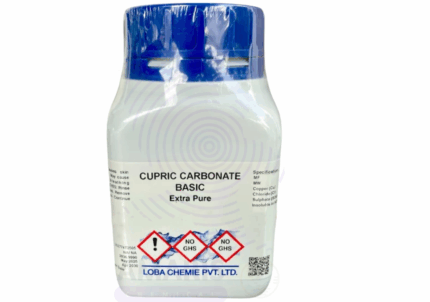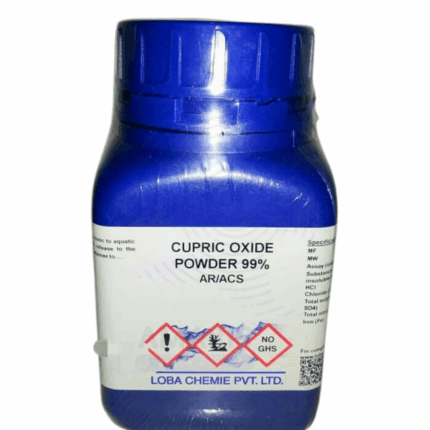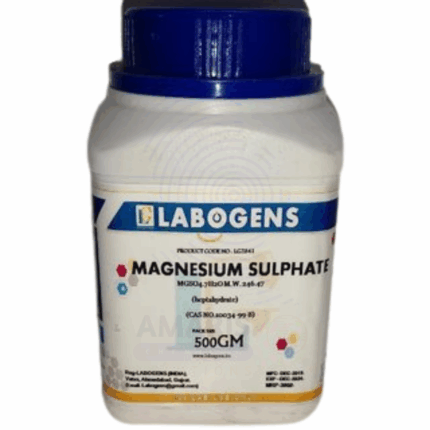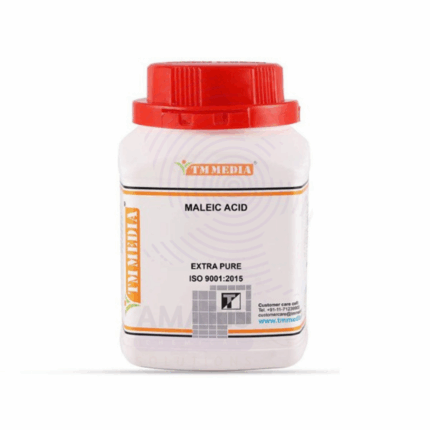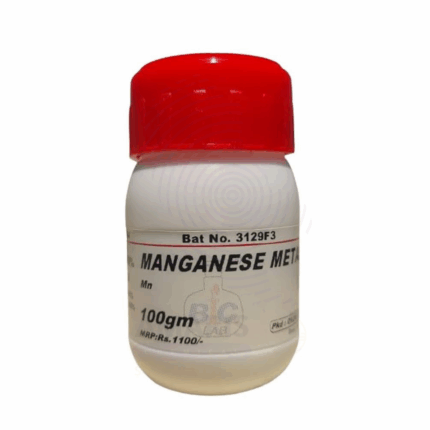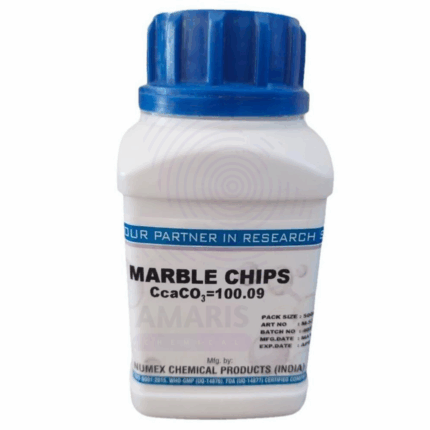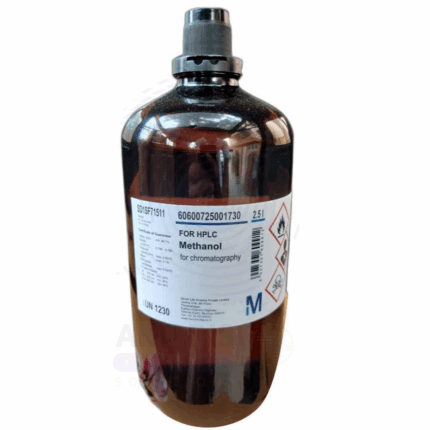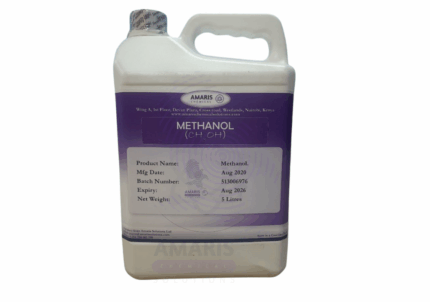
Manganous Dihydrogen Phosphate Extra Pure
$ 16.75 Original price was: $ 16.75.$ 16.67Current price is: $ 16.67.
Manganous Dihydrogen Phosphate Extra Pure is a high-purity, white to pale pink crystalline compound composed of manganese and phosphate ions. It is primarily used in analytical chemistry, research laboratories, and specialized industrial processes where a precise and reliable manganese source is required. This compound is valued for its solubility in water and its role as a reagent in studies involving nutrient uptake, coordination chemistry, and phosphate-related reactions. Additionally, it finds niche applications in fertilizers and micronutrient formulations, particularly in controlled agricultural studies. Its extra pure grade ensures minimal contamination, making it suitable for sensitive experiments and formulations.
Manganous Dihydrogen Phosphate Extra Pure
Primary Laboratory Uses:
- Source of Manganese in Analytical Chemistry:
- Used in qualitative analysis and preparation of calibration standards involving manganese ions (Mn²⁺).
- Plant Micronutrient Studies:
- Serves as a controlled manganese source in nutrient formulations for plant physiology experiments and hydroponics research.
Secondary Laboratory Uses:
- Precursor in Manganese Compound Synthesis:
- Can be used in the preparation of mixed metal phosphates, or thermally decomposed to form manganese oxides or phosphates.
- Catalysis Research:
- Occasionally studied as a component in heterogeneous catalyst systems, especially those involving transition metal phosphates.
- Educational Use:
- Utilized in academic settings to demonstrate metal phosphate solubility and acid salt reactions in laboratory teaching.
- Utilized in academic settings to demonstrate metal phosphate solubility and acid salt reactions in laboratory teaching.
| PACK SIZE |
500 grams Plastic Tin |
|---|
1. Basic Identification Attributes
- Chemical Name: Manganous Dihydrogen Phosphate
- Other Name: Manganese(II) dihydrogen phosphate
- CAS Number: 18718-07-5
- Molecular Formula: Mn(H₂PO₄)₂
- Molecular Weight: ~222.91 g/mol
- Appearance: Pale pink to light purple powder or crystalline solid
- Solubility: Soluble in water
- Grade: Extra Pure
2. Safety & Hazard Attributes
- GHS Classification:
- Eye irritation (Category 2A)
- Acute toxicity, oral (Category 4)
- STOT (Specific Target Organ Toxicity) – Repeated exposure, oral (Category 2)
- Hazard Statements:
- H302: Harmful if swallowed
- H319: Causes serious eye irritation
- H373: May cause damage to organs through prolonged or repeated exposure
- Precautionary Statements:
- P280: Wear protective gloves/protective clothing/eye protection
- P305+P351+P338: IF IN EYES: Rinse cautiously with water for several minutes
- P301+P312: IF SWALLOWED: Call a POISON CENTER if you feel unwell
- P501: Dispose of contents/container in accordance with regulations
- Personal Protective Equipment (PPE):
- Gloves
- Lab coat
- Safety goggles
- Dust mask or respirator if handling powder
- First Aid Measures:
- Inhalation: Move to fresh air, seek medical attention if symptoms occur
- Skin Contact: Wash thoroughly with water and soap
- Eye Contact: Rinse immediately with water; seek medical attention
- Ingestion: Rinse mouth; do not induce vomiting; seek medical help
- Fire Hazards:
- Non-flammable
- Use water spray, dry chemical, or CO₂ for surrounding fire
3. Storage & Handling Attributes
- Storage Conditions:
- Store in tightly sealed container
- Keep in a cool, dry, well-ventilated area
- Protect from moisture and strong oxidizers
- Handling Tips:
- Avoid contact with skin, eyes, and clothing
- Avoid inhalation of dust
- Handle under fume hood if possible
4. Laboratory Applications
- Primary Uses:
- Nutrient source of manganese and phosphate in plant and microbial studies
- Precursor compound for manganese-phosphate coordination chemistry
- Secondary Uses:
- Catalyst component in inorganic synthesis
- Reagent in materials research and surface treatment
SAFETY PRECAUTIONS
Personal Protective Equipment (PPE):
- Wear a lab coat, nitrile gloves, and safety goggles.
- Use a dust mask or operate within a fume hood to avoid inhaling dust particles.
Handling:
- Avoid inhalation, ingestion, and contact with skin or eyes.
- Prevent dust formation and ensure adequate ventilation during use.
- Wash hands thoroughly after handling and before eating or drinking.
Storage:
- Store in a cool, dry, and well-ventilated area.
- Keep the container tightly sealed and away from acids, oxidizing agents, and moisture.
- Protect from direct sunlight.
FIRST AID MEASURES
Inhalation:
- Move the person to fresh air.
- Seek medical attention if symptoms like coughing or respiratory irritation appear.
Skin Contact:
- Rinse with plenty of water and soap.
- Remove contaminated clothing.
- Get medical attention if irritation develops.
Eye Contact:
- Rinse cautiously with clean water for several minutes.
- Remove contact lenses if present and easy to do.
- Continue rinsing and seek medical advice if irritation persists.
Ingestion:
- Rinse mouth with water.
- Do not induce vomiting.
- Seek medical assistance immediately.
FIRE FIGHTING MEASURES
Flammability:
- Non-flammable under normal conditions.
- May decompose upon heating to release toxic fumes.
Extinguishing Media:
- Use dry chemicals, foam, CO₂, or water spray.
Hazardous Combustion Products:
- May emit phosphorus oxides and manganese oxides.
Firefighter Protection:
- Wear self-contained breathing apparatus (SCBA) and full protective clothing.


 Preservatives(food)
Preservatives(food) Flavor Enhancers
Flavor Enhancers Acidulants
Acidulants Sweeteners
Sweeteners Antioxidants
Antioxidants Colorants(food)
Colorants(food) Nutraceutical Ingredients (food)
Nutraceutical Ingredients (food) Nutrient Supplements
Nutrient Supplements Emulsifiers
Emulsifiers
 Collectors
Collectors Dust Suppressants
Dust Suppressants Explosives and Blasting Agents
Explosives and Blasting Agents Flocculants and Coagulants
Flocculants and Coagulants Frothers
Frothers Leaching Agents
Leaching Agents pH Modifiers
pH Modifiers Precious Metal Extraction Agents
Precious Metal Extraction Agents
 Antioxidants(plastic)
Antioxidants(plastic) Colorants (Pigments, Dyes)
Colorants (Pigments, Dyes) Fillers and Reinforcements
Fillers and Reinforcements Flame Retardants
Flame Retardants Monomers
Monomers Plasticizers
Plasticizers Polymerization Initiators
Polymerization Initiators Stabilizers (UV, Heat)
Stabilizers (UV, Heat)
 Antifoaming Agents
Antifoaming Agents Chelating Agents
Chelating Agents Coagulants and Flocculants
Coagulants and Flocculants Corrosion Inhibitors
Corrosion Inhibitors Disinfectants and Biocides
Disinfectants and Biocides Oxidizing Agents
Oxidizing Agents pH Adjusters
pH Adjusters Scale Inhibitors( water)
Scale Inhibitors( water)
 Antioxidants(cosmetic)
Antioxidants(cosmetic) Emollients
Emollients Fragrances and Essential Oils
Fragrances and Essential Oils Humectants
Humectants Preservatives
Preservatives Surfactants(cosmetic)
Surfactants(cosmetic) Thickeners
Thickeners UV Filters
UV Filters
 Fertilizers
Fertilizers Soil Conditioners
Soil Conditioners Plant Growth Regulators
Plant Growth Regulators Animal Feed Additives
Animal Feed Additives Biostimulants
Biostimulants Pesticides (Herbicides, Insecticides, Fungicides)
Pesticides (Herbicides, Insecticides, Fungicides)
 Active Pharmaceutical Ingredients (APIs)
Active Pharmaceutical Ingredients (APIs) Excipients
Excipients Solvents(pharmaceutical)
Solvents(pharmaceutical) Antibiotics
Antibiotics Antiseptics and Disinfectants
Antiseptics and Disinfectants Vaccine Adjuvants
Vaccine Adjuvants Nutraceutical Ingredients (pharmaceutical)
Nutraceutical Ingredients (pharmaceutical) Analgesics & Antipyretics
Analgesics & Antipyretics
 Analytical Reagents
Analytical Reagents Solvents(lab)
Solvents(lab) Chromatography Chemicals
Chromatography Chemicals Spectroscopy Reagents
Spectroscopy Reagents microbiology-and-cell-culture-reagents
microbiology-and-cell-culture-reagents Molecular Biology Reagents
Molecular Biology Reagents Biochemical Reagents
Biochemical Reagents Inorganic and Organic Standards
Inorganic and Organic Standards Laboratory Safety Chemicals
Laboratory Safety Chemicals Specialty Laboratory Chemicals(Special Laboratory Equipment)
Specialty Laboratory Chemicals(Special Laboratory Equipment)
 Demulsifiers
Demulsifiers Hydraulic Fracturing Fluids
Hydraulic Fracturing Fluids Scale Inhibitors(oil)
Scale Inhibitors(oil) Surfactants(oil)
Surfactants(oil) Drilling Fluids
Drilling Fluids
 Dyes and Pigments
Dyes and Pigments Bleaching Agents
Bleaching Agents Softening Agents
Softening Agents Finishing Agents
Finishing Agents Antistatic Agents
Antistatic Agents
 Admixtures
Admixtures Waterproofing Agents
Waterproofing Agents Sealants and Adhesives
Sealants and Adhesives Curing Compounds
Curing Compounds Concrete Repair Chemicals
Concrete Repair Chemicals Anti-Corrosion Coatings
Anti-Corrosion Coatings
 Surfactants(cleaning)
Surfactants(cleaning) Builders
Builders Enzymes
Enzymes Solvents (Cleaning)
Solvents (Cleaning) Fragrances
Fragrances
 Electronic Chemicals
Electronic Chemicals Catalysts
Catalysts Lubricants
Lubricants Photographic Chemicals
Photographic Chemicals Refrigerants
Refrigerants Automotive chemicals
Automotive chemicals Pyrotechnic Chemicals
Pyrotechnic Chemicals
 Biodegradable Surfactants
Biodegradable Surfactants Bio-based Solvents
Bio-based Solvents Renewable Polymers
Renewable Polymers Carbon Capture Chemicals
Carbon Capture Chemicals Wastewater Treatment Chemicals
Wastewater Treatment Chemicals
 Pigments
Pigments Solvents(paint)
Solvents(paint) Specialty Coatings
Specialty Coatings Binders/Resins
Binders/Resins Additives
Additives Driers
Driers Anti-Corrosion Agents
Anti-Corrosion Agents Functional Coatings
Functional Coatings Application-Specific Coatings
Application-Specific Coatings
 Fresh Herbs
Fresh Herbs Ground Spices
Ground Spices Whole Spices
Whole Spices Spice Blends
Spice Blends Dried Herbs
Dried Herbs
 Leavening Agents
Leavening Agents Dough Conditioners
Dough Conditioners Flour Treatments
Flour Treatments Fat Replacers
Fat Replacers Decoratives
Decoratives Preservatives(baking)
Preservatives(baking)
 Plasticizers & Softeners
Plasticizers & Softeners Reinforcing Agents
Reinforcing Agents Adhesion Promoters
Adhesion Promoters Vulcanizing Agents
Vulcanizing Agents Antidegradants
Antidegradants Blowing Agents
Blowing Agents Fillers & Extenders
Fillers & Extenders Accelerators & Retarders
Accelerators & Retarders


